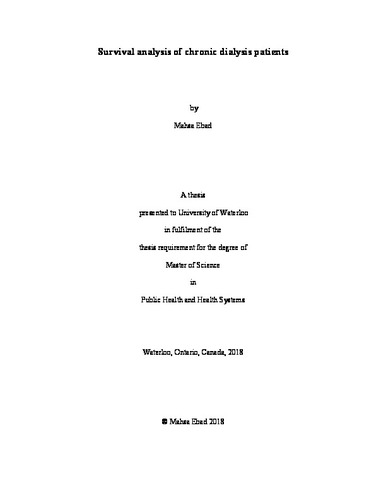| dc.contributor.author | Ebad, Mahsa | |
| dc.date.accessioned | 2018-08-13 19:31:00 (GMT) | |
| dc.date.available | 2018-08-13 19:31:00 (GMT) | |
| dc.date.issued | 2018-08-13 | |
| dc.date.submitted | 2018-07-17 | |
| dc.identifier.uri | http://hdl.handle.net/10012/13584 | |
| dc.description.abstract | Background: The number of dialysis patients is steadily rising in Canada because of demographic changes as well as an increased prevalence of associated risk factors such as hypertension, diabetes, and aging (Clark & Khan, 2010). Therefore, survival analysis of dialysis patients and the investigation of factors associated with survival outcome is crucial. This study aimed to estimate the survival rate of dialysis patients in Grand River Hospital (GRH), compare the survival outcome of Peritoneal Dialysis (PD) and Hemodialysis (HD) patients and assess the factors affecting survival outcome.
Methods: This retrospective study was based on the data on incident chronic dialysis patients (>30 days of dialysis) who initiated dialysis from January 2012 to September 2017. Acute dialysis patients and those who initiated dialysis before the start of the study were excluded. Kaplan-Meier (KM) survival curves were generated to estimate the overall survival of the cohort as well as by different age categories, gender and, type of modality. The Cox Proportional Hazard (PH) model was used to identify variables significantly associated with survival outcome.
Results: A total of 723 incident chronic dialysis with the average age of 64.86 years contributed to this analysis. The median survival time in this population was 39.8 months. Estimated 1-, 3- and 5- year survival rates were, 0.8, 0.54 and 0.34, respectively. Using the log-rank test, there was no statistical differences in survival outcome between patients undergoing HD and PD in this study (p=0.464). Backward elimination procedure with the two cut-offs (p>0.1 and p>0.2) resulted in two models in which hypertension was found to be significant in both (model A: adjusted HR = 0.62, p=0.013; model B: adjusted HR = 0.65, p=0.023).
Conclusion: This research showed comparable survival rates for incident chronic dialysis patients receiving care in GRH, similar survival experience of HD and PD patients and protective impact of hypertension on survival outcome. Long-term survival outcome results were similar between both groups; however, PD patients had an improved survival outcome during the first 18 months of the study. | en |
| dc.language.iso | en | en |
| dc.publisher | University of Waterloo | en |
| dc.subject | dialysis | en |
| dc.subject | survival analysis | en |
| dc.subject | chronic | en |
| dc.title | Survival analysis of chronic dialysis patients | en |
| dc.type | Master Thesis | en |
| dc.pending | false | |
| uws-etd.degree.department | School of Public Health and Health Systems | en |
| uws-etd.degree.discipline | Public Health and Health Systems | en |
| uws-etd.degree.grantor | University of Waterloo | en |
| uws-etd.degree | Master of Science | en |
| uws.contributor.advisor | Chen, Helen | |
| uws.contributor.affiliation1 | Faculty of Applied Health Sciences | en |
| uws.published.city | Waterloo | en |
| uws.published.country | Canada | en |
| uws.published.province | Ontario | en |
| uws.typeOfResource | Text | en |
| uws.peerReviewStatus | Unreviewed | en |
| uws.scholarLevel | Graduate | en |

